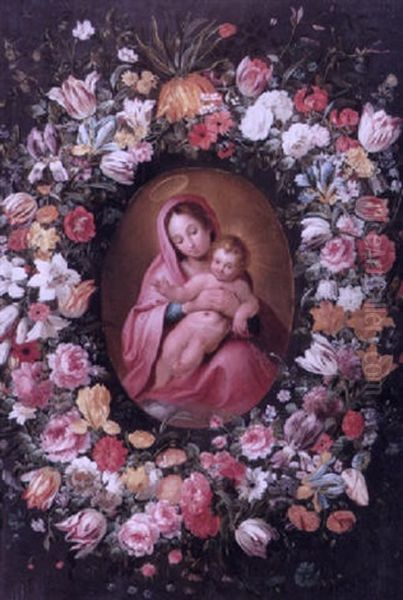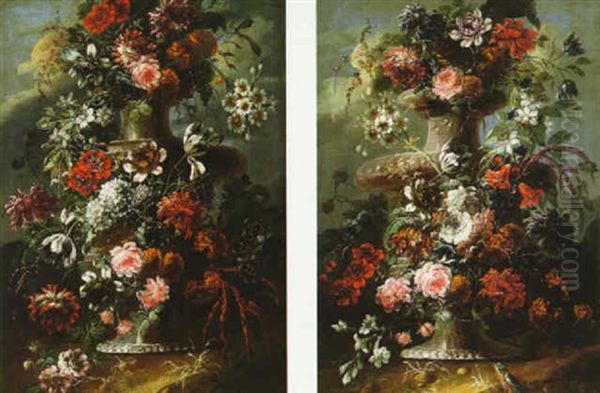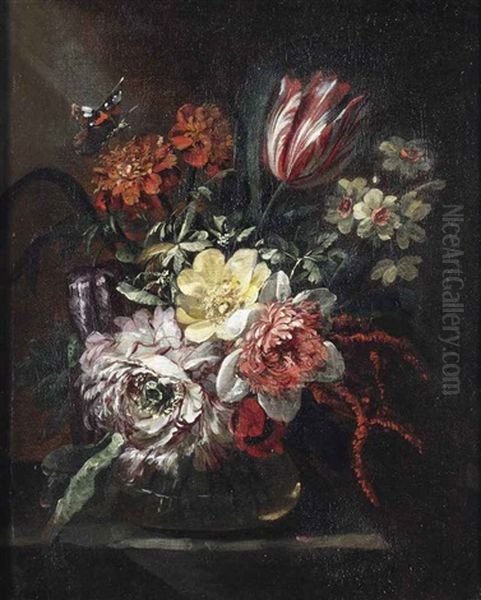Jean-Baptiste Morel (1662-1732) stands as a notable figure in the rich tapestry of Flemish Baroque art, particularly celebrated for his exquisite still life paintings. Specializing in the depiction of flowers, intricate garlands, and occasionally bas-reliefs, Morel carved a niche for himself during a period when the demand for such decorative and meticulously rendered artworks was at its peak. Born in the bustling artistic hub of Antwerp and later establishing his career in Brussels, his work reflects both the technical brilliance and the aesthetic sensibilities of the late 17th and early 18th centuries in the Southern Netherlands.
Early Life and Artistic Formation in Antwerp
Jean-Baptiste Morel was born in Antwerp in 1662, a city that had long been a powerhouse of artistic innovation and production in Europe. While the towering figures of Peter Paul Rubens and Anthony van Dyck had passed from the scene by this time, their legacy had profoundly shaped the artistic environment. Antwerp remained a center for high-quality painting, with numerous workshops specializing in various genres, including the increasingly popular still life.
It was in this vibrant atmosphere that Morel began his artistic training. In 1674, at the age of twelve, he was apprenticed to Nicolas van Verendael (also spelled Nicolaes van Verendael or Veraendael). Van Verendael (1640-1691) was himself a respected still life painter in Antwerp, known for his delicate flower pieces, fruit still lifes, and particularly for his "girlandes" or garland paintings. This genre, popularized by artists like Jan Brueghel the Elder and Daniel Seghers, involved a lush wreath of flowers, fruit, or other objects surrounding a central cartouche, which might contain a religious scene, a portrait, or a mythological subject, often painted by another artist.

Under Verendael's tutelage, Morel would have learned the meticulous techniques required for still life painting: the precise rendering of textures, the subtle play of light and shadow, and the careful arrangement of objects to create harmonious and often symbolic compositions. The emphasis would have been on direct observation and the faithful representation of nature, albeit often an idealized or artfully composed version of it. The tradition of flower painting in Antwerp was strong, with artists striving to capture the ephemeral beauty of blooms from different seasons, often combined into a single, impossible bouquet.
The Move to Brussels and Career Development
After establishing a degree of success in Antwerp, Jean-Baptiste Morel made a significant career move in 1695, relocating to Brussels. This decision was reportedly driven by the increasing demand for his specialized skills in the capital city of the Spanish (and later Austrian) Netherlands. Brussels, as a political and administrative center, offered significant opportunities for patronage from the court, aristocracy, and wealthy burghers.
Upon his arrival or shortly thereafter, Morel sought to integrate himself into the local artistic community by becoming a member of the Brussels Guild of Saint Luke. The guilds were powerful institutions that regulated the art trade, controlled apprenticeships, and maintained quality standards. Membership was typically essential for an artist to practice independently, take on pupils, and sell their work openly within the city.
Morel's talent did not go unnoticed. He received prestigious commissions, including work for the Governor of the Southern Netherlands, decorating the ducal palace in Brussels. This indicates a high level of recognition and suggests that his floral compositions and decorative paintings were well-suited to the opulent interiors of the period. His works, characterized by their vibrant colors, detailed execution, and elegant arrangements, appealed to the prevailing taste for refinement and naturalistic beauty.
However, Morel's relationship with the Guild of Saint Luke in Brussels appears to have had its complexities. There is a record indicating that at one point, some of his works were seized and publicly exhibited, allegedly because he was unwilling to join or perhaps had a dispute regarding his membership or its obligations. Such conflicts were not uncommon, as guilds could be very protective of their members' privileges. Despite this apparent hiccup, Morel seems to have resolved any issues, as it is documented that he formally (re)joined the Brussels Guild in 1729, a few years before his death. This reaffirms his standing within the official artistic structures of the city.
Artistic Style, Specialization, and Representative Works

Jean-Baptiste Morel's oeuvre is primarily defined by his dedication to still life, with a particular emphasis on flower paintings and garlands. His style is rooted in the Flemish Baroque tradition, which valued verisimilitude, rich coloration, and often, a sense of abundance and vitality. His training under Nicolas van Verendael would have instilled in him a meticulous approach to detail and a sensitivity to the delicate forms and textures of flowers.
His flower pieces typically feature a variety of blooms, often including popular choices like roses, tulips, carnations, peonies, and irises, arranged in ornate vases or as part of more elaborate compositions. These arrangements were not always botanically accurate in terms of seasonal availability; rather, they were artistic constructions designed to showcase a diversity of form and color, creating a "perfect" bouquet that could not exist in nature. The play of light on petals and leaves, the rendering of dewdrops, and the occasional inclusion of insects like butterflies or caterpillars added to the realism and symbolic depth of these works.
Morel was also known for his garland paintings, a genre in which his master, Verendael, excelled. These works often involved a central element – perhaps a sculpted cartouche, a religious image, or a portrait – encircled by a lush wreath of flowers and fruits. One notable example attributed to Morel is a painting described as "Garland," considered a masterpiece from the late 17th century. Interestingly, the central part of this particular work was reportedly left unfinished, allowing the viewer to focus entirely on the virtuosity of the surrounding floral decoration. The design of such borders often incorporated architectural forms and demonstrated an understanding of classical aesthetics, showcasing Morel's skill in creating complex, decorative compositions.
His paintings would have been admired for their decorative qualities, fitting perfectly into the lavish interiors of aristocratic and wealthy bourgeois homes. The precision of his brushwork, the vibrancy of his palette, and the elegance of his compositions ensured his popularity among patrons who appreciated the beauty and technical skill inherent in such works. While perhaps not as revolutionary as some of his predecessors, Morel capably carried forward the established traditions of Flemish still life painting into the early 18th century.
The Artistic Milieu: Contemporaries and Influences
Jean-Baptiste Morel operated within a rich and competitive artistic environment. The tradition of still life painting in the Low Countries was incredibly strong, with numerous artists specializing in various sub-genres. His direct master, Nicolas van Verendael, was a key influence, but the broader context included many other significant figures.

The foundations for Flemish flower painting had been laid by artists like Jan Brueghel the Elder (1568-1625), whose "velvet" touch and encyclopedic depiction of flowers set a high standard. Daniel Seghers (1590-1661), a Jesuit painter and student of Brueghel, became famous for his garland paintings, often collaborating with leading figure painters like Peter Paul Rubens (1577-1640) and Cornelis Schut (1597-1655), who would paint the central scenes. While these artists were of an earlier generation, their influence persisted.
Among Morel's closer contemporaries or those whose careers overlapped significantly, several names stand out in the realm of still life. Jan Philips van Thielen (1618-1667), though slightly earlier, was another prominent flower painter who had also studied with Seghers. Jan van Kessel the Elder (1626-1679) was renowned for his small, jewel-like paintings of flowers, insects, and shells, often on copper. In the Northern Netherlands (Holland), artists like Jan Davidsz. de Heem (1606-1684), who also worked in Antwerp for a period, created opulent "pronkstilleven" (ostentatious still lifes) that often included flowers. Later Dutch flower painters who were Morel's contemporaries included Rachel Ruysch (1664-1750) and Jan van Huysum (1682-1749), both of whom achieved international fame for their highly refined and luminous floral compositions.
While Morel specialized in still life, the broader art scene in the Southern Netherlands during his lifetime still saw activity in other genres, though perhaps not with the same groundbreaking impact as in the earlier 17th century. Artists continued to produce religious paintings, portraits, and landscapes. The demand for decorative art, including tapestries for which Brussels was famous, also provided a backdrop for Morel's specialized output. His works would have been seen alongside those of other Flemish painters active in Brussels and Antwerp during this period, contributing to the overall artistic vibrancy of the region. French artists like Jean-Baptiste Monnoyer (1636-1699), known as 'Baptiste', also specialized in flower painting and achieved great success, including in England, indicating the widespread European taste for this genre. Morel's works were also sold on the London market, suggesting an international reach for his art.
Personal Life

Details about Jean-Baptiste Morel's personal life are somewhat sparse, as is common for many artists of this period unless they achieved exceptional fame or were involved in notable documented events. However, we do know that he was married twice. His first marriage was in 1689 to Marie Lamy (or Lamboy). Following her death, he married Anne-Marie van Hempt, who hailed from a noble family in Brussels. This second marriage suggests that Morel had achieved a certain social standing, as unions across distinct social strata, while not impossible, often indicated the groom's established reputation and financial stability. These marriages place him within the social fabric of Antwerp and later Brussels, but further details about his family life or children are not readily available in the provided summary.
Legacy and Collections
Jean-Baptiste Morel passed away in Brussels in 1732. His legacy lies in his contribution to the enduring tradition of Flemish still life painting. His works are characterized by their technical proficiency, decorative appeal, and adherence to the high standards of the genre. While he may not be as widely known today as some of the pioneering figures of the early Baroque, his paintings are valued for their beauty and as representative examples of late Baroque floral art in the Southern Netherlands.
His paintings are preserved in several museum collections, which allows contemporary audiences to appreciate his skill. Notably, his works can be found in the Musée des Beaux-Arts de Tournai (often referred to as the Tournai Castle Museum in some sources, though the primary art museum is the Musée des Beaux-Arts), the Palais des Beaux-Arts de Lille (Lille Museum of Fine Arts) in France, and the Wallraf-Richartz Museum in Cologne, Germany. The presence of his works in these public collections attests to their historical and artistic significance.
The art market also continues to acknowledge Morel's contributions, with his paintings appearing at auctions where they are appreciated by collectors of Old Master paintings, particularly those specializing in still lifes.
Clarifying Identity: Distinguishing Jean-Baptiste Morel the Painter
It is crucial to distinguish Jean-Baptiste Morel, the Flemish flower painter (1662-1732), from other historical figures who share similar names, as this has led to considerable confusion in some aggregated biographical accounts.
Firstly, there is mention of him being potentially confused with a Nicolas Moreel. While the provided information suggests Jean-Baptiste Morel is indeed a distinct artist, it's a point of minor historical ambiguity that sometimes arises in older art historical records. However, the consensus supports his independent identity as a painter.
More significantly, several anecdotes and achievements attributed to "Jean Morel" or "Jean-Baptiste Morel" in the provided source material clearly refer to different individuals from different eras and professions:
1. The "Mistakenly Buried Alive" Anecdote: The story of a Jean-Baptiste Morel being mistakenly declared dead and buried, only to be found alive later, with details recorded by the French Academy of Sciences, does not align with the known biography of the Flemish painter. This likely refers to a different person, possibly French, involved with the scientific community there.
2. Jean Morel and the Protestant Reformation: The Jean Morel mentioned as an early French Protestant reformer, arrested for his beliefs, tortured, and dying in prison in 1559, is unequivocally a different person. This Jean Morel was a religious martyr of the 16th century, more than a century before the painter's birth.
3. Jean-Baptiste Morel, the Goldsmith/Gem Carver: The artist who created a complex cup for the Rothschild family in 1836, showcasing skills in hardstone carving and goldsmithing, is Jean-Valentin Morel (1794-1860), a prominent 19th-century French goldsmith and jeweler. This is clearly not the 17th-18th century Flemish painter.
4. Bénédict Augustin Morel and Psychiatry: The Jean-Baptiste Morel credited with contributions to psychiatry, particularly the "degeneracy" theory and writings like "Traité des dégénérations physiques" (1857) and "Traité des maladies mentales" (1860), is Bénédict Augustin Morel (1809-1873). He was a highly influential French psychiatrist of the 19th century, and his work has no connection to the Flemish Baroque painter.
It is essential for art historical accuracy to keep these identities separate. The Jean-Baptiste Morel who concerns us here is solely the painter of flowers and still lifes, active in Antwerp and Brussels between 1662 and 1732.
Conclusion
Jean-Baptiste Morel was a skilled and respected practitioner of still life painting in the late Flemish Baroque period. As a pupil of Nicolas van Verendael, he inherited a tradition of meticulous detail and elegant composition, which he applied to his favored subjects of flowers and garlands. His move from Antwerp to Brussels marked a successful phase in his career, where he gained patronage and membership in the Guild of Saint Luke. While his name might occasionally be muddled with other historical figures, his artistic contributions stand on their own. His paintings, found in museums and private collections, continue to delight viewers with their vibrant beauty and serve as a testament to the enduring appeal of floral still life and the rich artistic heritage of the Southern Netherlands. He remains a significant, if sometimes overlooked, artist within his specialized genre, representing the continuity of a celebrated artistic tradition into the 18th century.